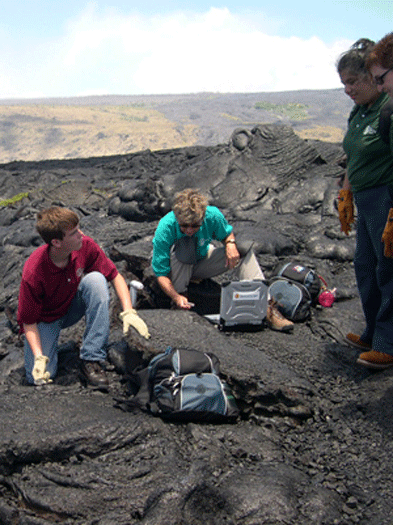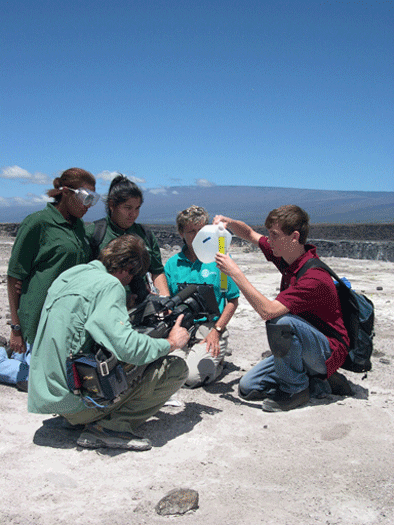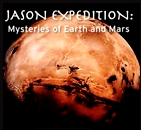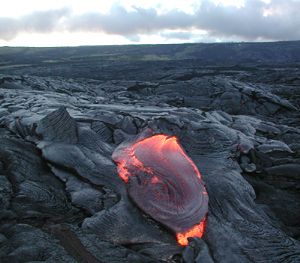 |
JASON Argonauts examine lava as part of JASON Expedition: Mysteries of Earth and Mars. (R to L) Luke Iott; Marti Dekker; Anabel Hernandez; and Planetary Geologist at the University of Hawai`i, Vicky Hamilton, Ph.D. |
 |
How did you end up in the field you are in today?
I ended up being a scientist by accident. I had not planned on a career in science, but I discovered geology in college. During my junior year at Occidental College (Los Angeles), I received a NASA fellowship and was given the opportunity to work with the NASA Magellan Science Team at the Jet Propulsion Laboratory in Pasadena, CA. I spent a summer analyzing new data acquired at Venus by the Magellan spacecraft, making geologic maps from the wonderful new images. While I was there, I decided that I wanted a job studying data and pictures of other planets. I graduated college with a degree in Geology in 1993, and wrote my senior thesis about the research I had done with the Magellan Venus data. I decided that I wanted to pursue a Ph.D. immediately, and I entered the Ph.D. program at Arizona State University to work with Dr. Philip Christensen, who designed and built a thermal emission spectrometer (TES) that was on its way to Mars. That mission, Mars Observer, failed, but the TES and many of the other Mars Observer instruments were re-flown to Mars on a mission called Mars Global Surveyor, which successfully arrived at Mars just as I was finishing my Ph.D.
What do you like best about your job?
I think the best parts of my job are getting to look at data from another planet, and being my own boss. Only a few people on Earth have seen many of the pictures and spectra that I look at every day, and that is something very exciting and special to me.
What was your favorite subject when you were in middle school?
In middle school, I liked Spanish a lot, and was really intrigued by foreign languages. I never felt good at, nor did I enjoy, math; science was okay, but not my favorite subject either. I think that at the time I got a lot of encouragement to do what I liked and keep an open mind.
Why do you think it is important for students to learn about our solar system and specifically about Mars?
I think it's not only important to understand the Earth and how it works as a planet, but also the ways in which other planets are like or different than Earth. Having a fundamental understanding of how our solar system and the universe formed is important to us not only scientifically, in terms of the processes that are happening now and have happened in the past, but also in terms of understanding where we come from, and whether or not there might be other life forms somewhere else. Mars has many of the same geologic features as the Earth, but they are quite different in terms of scale, and the climate of Mars appears to have changed over time. Many scientists believe that Mars may have been hospitable to life at one time, and we'd like to know if that life ever started. If it did, what happened to it is very important, and if it didn't, it becomes interesting to understand why. Understanding the climate history of Mars may be important to us here on Earth, in terms of what our future may hold. In terms of making comparisons, we can use what we observe up close here on Earth to help us understand what we're seeing on Mars, which we cannot get to ourselves
What would you most like students to learn from participating in the JASON Expedition: Mysteries of Earth and Mars?
I think there are two things that are important to me about this Expedition. First, I'd like students who might be afraid of science to realize that it can be an adventure and doesn't have to be intimidating; it's so much more exciting than balancing chemical formulas or doing math problems. Secondly, I hope that as a female, I can be a positive role model for young girls who might be interested in science and math, but may not think that they can do it.
What advice would you give to students who are interested in studying science?
For the students who are already interested in science, I would simply encourage them to try to look outside the typical classes (biology, chemistry, physics) that are taught in middle and high school for other options in science. Find out about geology, geography, marine sciences, astronomy, and engineering. Students should know that there's a science for everyone -- if you like to be outdoors, and love the beach, there's a science that will let you be there. If you like to be indoors and work with computers, there's a field in science that will let you do that too. There are dozens of careers involved in planetary science. In addition to scientists, NASA hires accountants, teachers, artists, writers, engineers, mechanics, computer programmers, pilots, doctors, and of course, astronauts!
 |
JASON Argonauts (R to L) Talicia Calhoun, Anabel Hernandez, teacher Marti Dekker, and Luke Iott test a soil sample at Hawai`i Volcanoes National Park.
|
 |
Participating in extracurricular activities keeps Anabel busy. She has volunteered at the Centro Hispano, helping young children at day camp, and has been involved with the Junior National Young Leaders Conference, United States Academy Achievement and Creative Communications.
Page created on 8/27/2011 12:00:00 AM
Last edited 8/27/2011 12:00:00 AM

For over a decade JASON Expeditions have taken place around the globe.

Summer of 2005's JASON Project expedition, “Mysteries of Earth and Mars,” explored several different locations around the United States. The student and teacher “Argonauts," along with a team of renowned researchers and scientists, helped "unravel the mysteries of Earth and Mars" as they compared the two planets through exciting scientific exploration!
Scientists know that Earth and Mars share a common origin in the solar system, yet are two planets which evolved very differently. By visiting locations on Earth whose environment could best be paralleled with that of Mars, and which, despite extreme conditions, have life forms thriving therein, the JASON team was able to theorize about the types of life that could potentially exist in the extreme conditions of 'the red planet' as well.

Like Earth, Mars is home to many volcanoes, but because of a lack in platetectonic activity, the lava piles up much more dramatically, and the volcanoes are much larger, in some cases, 100 times so!
In exploring a national park which hosts both the earth's most massive volcano, Mauna Loa, and the world's most active volcano, Kilauea, the team experienced an area that 'displays the results of 70 million years of volcanism, migration, and evolution — processes that thrust a bare land from the sea and clothed it with complex and unique ecosystems.'